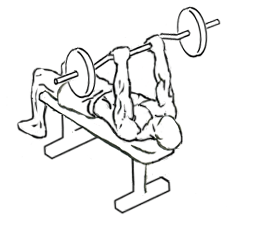Last Updated on September 30, 2022
The Decline EZ Bar Triceps Extension, also known as the decline skull crusher, is a powerful isolation exercise that targets the triceps muscles with increased effectiveness by utilizing a decline bench and an EZ bar (curved barbell). This exercise emphasizes the long head of the triceps, which is crucial for building overall arm size and strength. The decline position adds extra resistance, intensifying the triceps’ engagement compared to flat or incline extensions.
In this detailed guide, we will explore the benefits, proper technique, common mistakes, and how to integrate the decline EZ bar triceps extension into your workout routine to maximize muscle development and strength.
What is the Decline EZ Bar Triceps Extension?
The decline EZ bar triceps extension is a variation of the standard triceps extension performed on a decline bench. By lying at an angle where your head is positioned lower than your feet, the decline position shifts more tension onto the triceps long head, providing a more intense workout than the flat bench variation.
This exercise involves extending your arms with an EZ bar (curved barbell), which is preferred for its ergonomic design. The curve of the EZ bar allows for a more natural grip, reducing strain on the wrists and elbows while effectively isolating the triceps.
Muscles Worked in the Decline EZ Bar Triceps Extension
The decline EZ bar triceps extension primarily targets the triceps brachii, specifically the long head of the triceps. However, other supporting muscles are also activated during the movement:
- Triceps Brachii: The main muscle worked in this exercise, the triceps, is composed of three heads: the long head, lateral head, and medial head. This exercise places extra emphasis on the long head, which contributes to overall arm size.
- Anterior Deltoids (Shoulders): While not a primary mover, the front part of the shoulders assists in stabilizing the arms during the movement.
- Core Muscles: Engaging your core helps to stabilize your body on the decline bench, ensuring proper form throughout the exercise.
- Forearms: As you grip and control the EZ bar, your forearms work to stabilize and maintain control of the weight, particularly during the lowering phase of the movement.
Benefits of the Decline EZ Bar Triceps Extension
Adding the decline EZ bar triceps extension to your workout routine offers several benefits that can enhance both your strength and overall physique:
- Maximized Triceps Engagement: The decline angle adds extra resistance to the movement, which puts more tension on the triceps, especially the long head. This leads to greater activation and muscle development over time.
- Reduced Stress on the Elbows and Wrists: The ergonomic design of the EZ bar allows for a more natural hand position compared to a straight bar, reducing the strain on your wrists and elbows during the exercise.
- Improved Arm Strength and Size: The decline position increases the intensity of the exercise, helping to build both strength and size in the triceps, contributing to more defined, muscular arms.
- Better Muscle Isolation: Since this is an isolation exercise, it focuses almost entirely on the triceps, minimizing the involvement of other muscle groups. This makes it an ideal exercise for targeting triceps growth.
- Variety for Muscle Growth: Incorporating this variation into your triceps routine provides a different stimulus compared to flat or incline triceps extensions. Adding variety to your workouts prevents plateaus and promotes continuous muscle growth.
Proper Technique for Decline EZ Bar Triceps Extension
Performing the decline EZ bar triceps extension with proper form is essential to ensure you get the most out of the exercise while avoiding injury. Follow these steps for optimal results:
- Set up the decline bench: Adjust the decline bench to an angle of about 15 to 30 degrees. Make sure your feet are securely placed under the footpads to prevent sliding, and position your body so that your head is lower than your feet.
- Grip the EZ bar: Grasp the EZ bar with an overhand grip (palms facing forward), placing your hands slightly narrower than shoulder-width apart on the curved portions of the bar. This grip allows for a more natural movement that minimizes strain on your wrists and elbows.
- Position your arms: Lie back on the decline bench and extend your arms so that they are perpendicular to your chest. The bar should be directly above your shoulders at the starting position. Keep your elbows tucked in and fixed in place throughout the movement.
- Lower the bar: Slowly lower the EZ bar in a controlled manner toward your forehead or just behind your head. Focus on keeping your upper arms stationary—only your forearms should be moving. As you lower the bar, feel the stretch in your triceps.
- Extend the bar back up: Once the bar reaches its lowest point, engage your triceps to lift the bar back to the starting position. Make sure to extend your arms fully, but avoid locking out your elbows to maintain tension on the triceps.
- Repeat: Perform the desired number of repetitions, typically 3 to 4 sets of 8 to 12 reps. Focus on slow, controlled movements to ensure maximum muscle engagement.
Common Mistakes to Avoid
To ensure you get the most out of the decline EZ bar triceps extension and avoid injury, it’s important to be aware of common mistakes:
- Flaring the Elbows: Allowing your elbows to flare out during the movement can shift the focus away from the triceps and put unnecessary strain on the shoulders. Keep your elbows tucked in throughout the exercise to fully engage the triceps.
- Using Too Much Weight: While lifting heavy can be tempting, using too much weight can lead to improper form, especially in an isolation exercise like this. Start with a weight you can control, and focus on proper technique.
- Not Controlling the Descent: Dropping the bar too quickly reduces time under tension and increases the risk of injury. Lower the bar slowly and in a controlled manner to maximize muscle activation.
- Locking the Elbows: Locking your elbows at the top of the movement takes the tension off the triceps and places unnecessary stress on the joints. Keep a slight bend in your elbows throughout the exercise.
- Arching the Lower Back: To avoid lower back strain, engage your core muscles and keep your back pressed against the bench. Excessive arching can lead to injury and reduce the effectiveness of the exercise.
Variations of the Decline EZ Bar Triceps Extension
Once you’ve mastered the standard decline EZ bar triceps extension, you can try these variations to add more challenge to your workout and target your triceps from different angles:
- Flat Bench EZ Bar Triceps Extension: Perform the same movement on a flat bench to target the triceps without the additional resistance of the decline position. This variation is less intense but still effective.
- Incline EZ Bar Triceps Extension: Use an incline bench to shift the emphasis to different parts of the triceps. This variation engages the triceps from a slightly different angle, adding variety to your routine.
- Dumbbell Triceps Extension: Use dumbbells instead of an EZ bar for a unilateral version of the exercise. This variation helps correct muscle imbalances by allowing each arm to work independently.
- Cable Triceps Extension: Use a cable machine with a rope attachment to perform the same movement. Cables provide constant tension throughout the range of motion, which can enhance muscle activation.
- Single-Arm EZ Bar Triceps Extension: Perform the exercise with one arm at a time to further isolate each triceps muscle and improve balance.
How to Incorporate the Decline EZ Bar Triceps Extension into Your Workout Routine
The decline EZ bar triceps extension can be a valuable addition to any upper body or arm-focused workout. Here’s how to effectively incorporate it into your routine:
- Frequency: Aim to include this exercise in your routine 1 to 2 times per week, depending on your training split. It works well as part of an arm day or as a secondary movement on a chest or push day.
- Reps and Sets: For muscle growth, perform 3 to 4 sets of 8 to 12 reps. For strength, opt for 4 to 5 sets of 4 to 6 reps with heavier weight.
- Pair with Other Triceps Exercises: Combine the decline EZ bar triceps extension with other triceps exercises, such as dips, close-grip bench presses, or cable pushdowns, for a complete triceps workout.
- Rest Between Sets: Allow 60 to 90 seconds of rest between sets to give your muscles time to recover while maintaining intensity.
Sample Triceps Workout
Here’s a sample workout that incorporates the decline EZ bar triceps extension into a full triceps routine:
- Close-Grip Bench Press – 4 sets of 8-10 reps
- Decline EZ Bar Triceps Extension – 4 sets of 8-12 reps
- Cable Triceps Pushdown – 3 sets of 10-12 reps
- Triceps Dips (Bodyweight or Weighted) – 3 sets of 8-10 reps
- Overhead Dumbbell Triceps Extension – 3 sets of 10-12 reps
Conclusion
The decline EZ bar triceps extension is an excellent isolation exercise for building strong, defined triceps. By utilizing the decline bench and the ergonomic design of the EZ bar, this exercise offers an intense triceps workout with minimal strain on the wrists and elbows. Whether you’re aiming to build stronger arms, improve muscle definition, or simply add variety to your upper body routine, the decline EZ bar triceps extension should be a staple in your workout.
By following the correct technique, avoiding common mistakes, and progressively increasing the weight, you can maximize your gains and minimize the risk of injury. The added resistance from the decline bench makes this exercise particularly effective for targeting the long head of the triceps, which is crucial for overall arm size and strength.
Final Tips for Success
- Focus on Form: Proper form is key to ensuring that you’re effectively targeting the triceps and avoiding injury. Keep your elbows tucked in, control the descent, and don’t rush through the movement.
- Warm Up Properly: Before performing any triceps-focused exercises, make sure to warm up your elbows and arms. Light cardio and dynamic stretches will help get the blood flowing and prepare your joints for the workout.
- Start Light: If you’re new to this exercise, start with a lighter weight to master the technique. Once you’re comfortable with the form, gradually increase the load to keep challenging your muscles.
- Use a Spotter: For added safety, especially when lifting heavier weights, consider using a spotter to help control the bar during the lowering phase of the exercise.
- Incorporate It Into Your Routine: The decline EZ bar triceps extension works best when combined with other triceps exercises in a comprehensive arm or push workout. Mix it with other triceps and chest movements to achieve balanced upper body development.
- Stay Consistent: Like any strength-building exercise, consistency is crucial for long-term results. Include the decline EZ bar triceps extension in your routine regularly to see noticeable improvements in your triceps strength and size.
Conclusion
The decline EZ bar triceps extension is a highly effective exercise for isolating and building the triceps, especially the long head. By incorporating this movement into your workout routine, you’ll be well on your way to stronger, more defined arms. It’s an excellent addition to any upper body program, offering a unique angle that enhances muscle activation and reduces joint strain.
Whether you’re a beginner or an advanced lifter, the decline EZ bar triceps extension can help you achieve your arm-strengthening goals. Stick with proper form, focus on controlled movement, and gradually increase the weight to keep progressing and building your triceps over time.


Exercise images by Everkinetic.





